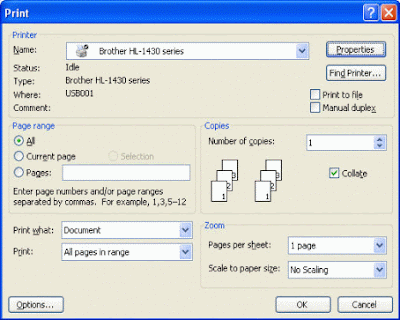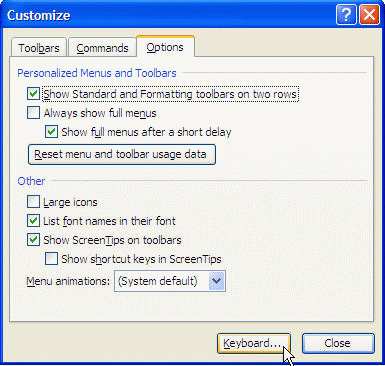Document printing is easy right? Just click on the print icon!But before you print,Microsoft Word requires that a printer driverhas been installed in your computer and matches the printer you are currently using. ONthe printer.
The 3-step below guides you to proper document printing inMicrosoft Word:
Step 1: To Preview a Document
Place the insertion point in the page where you want the documentpreview to begin.From the File menu, click Print Preview.Click once in the document to view it more closely and click again to zoom back out.On top of the screen, you will see the Print Preview toolbar. Each of the toolbar icon will have their own function as describe below:
| Print | The document is send to the printer. |
| Magnifier | The same as clicking inside the document. It gives a single-level zoom. |
| One Page | Single-page view. |
| Multiple Pages | Allows you to print preview up to six pages at a time on the screen. |
| Zoom Control | Allows you to control Zoom view percentages. |
| View Ruler | Allows you to view the ruler showing tabs and measurements. |
| Shrink to Fit | Enables you to fit a document that is just more than one page long into a single page. |
| Full screen | Allows you to change to Full Screen view. |
| Close | Allows you to leave Print Preview and return to the MS Word screen. |
Note: The step 1 of document printing here is to let you see (preview) the document. If you satisfied, only proceed to the step 2 otherwise just make the necessary changes.
Step 2: To Change the Printer Settings
From the File menu, click Print.From the Print dialog box displayed, you needs to do some settings as describe below:
Printer:| Name | Select the printer you wish to use from the list of installed printers. |
| Properties button | Important! Refer below. |
| Print to file | Will print the document to another file, rather than the printer. |
Page range:
| All | Will print all the pages of a document. |
| Current page | Will print the current page only. |
| Pages | Allows you to print a single page, a range of pages, or disconnected ranges of pages. Enter the value such as 1, 5-9, 18, 25-33. |
Print what:
| Document | Will print the document (normally we choose this option). |
| Document Properties | Will print summary information about the current document such as file size, word count, etc. |
| Document Showing markup | Will print the document that show markup. Note: Markup features can quickly see who made changes to your document, because Word color codes changes by reviewer. |
| List of markup | Will print the list of markup. |
| Styles | Will print the construction and set up of the styles for the current document. |
| AutoText entries | Will print the AutoText entries for the current document. |
| Key assignments | Will print the keystroke assignments that are used inMicrosoft Word. |
Print:
| All pages in range | Will print all of the pages in a specified range. |
| Odd pages | Will print only the odd pages of a document. |
| Even pages | Will print only the even pages of a document. |
Copies:
| Number of copies | Enter the number in the box will specify the number of copies that you wish to print the document. |
| Collate | Will print an entire copy of a document before the next copy of it begins to print. When you select this option, MS Word creates the number of copies specified, and then sends all the copies tothe printer. Printing takes longer if you choose the option. |
Zoom:
| Pages per sheet: | Will specify the number of pages in a sheet of paper, range from 1 page up to 16 pages. |
| Scale to paper size: | Specify the different types of paper size to be use. |
The Properties Button
Important: You need to click on this button, as it will let you set the printing paper size, paper orientation, color or black/white printing, etc.This is critical, as it will affect the printing output. However, different printer installed will have slightly different settings. Click OK when finish and return to the Print dialog box.
Note: The step 2 of document printing is very important as you are required to change the printer related settings so that the outputs come out will fulfill your needs.
Step 3: To Print
To accept the printer selection and setup, and print the document clickon the OK button.Before hit the OK button, ensure that you have put the plain papers tothe printer tray.To return to your document without printing, choose Cancel.






